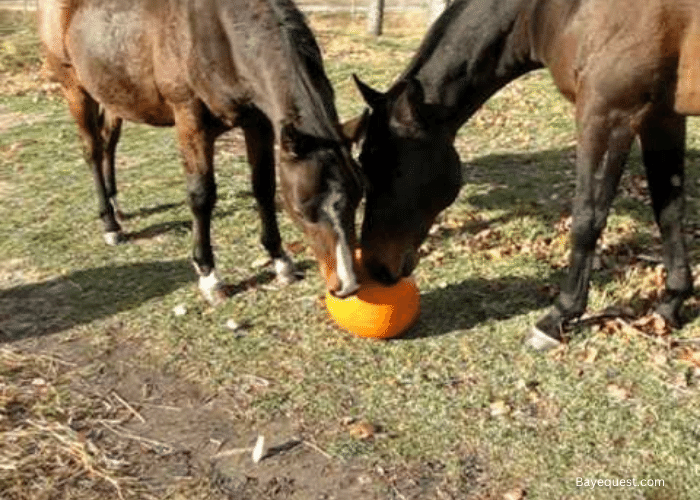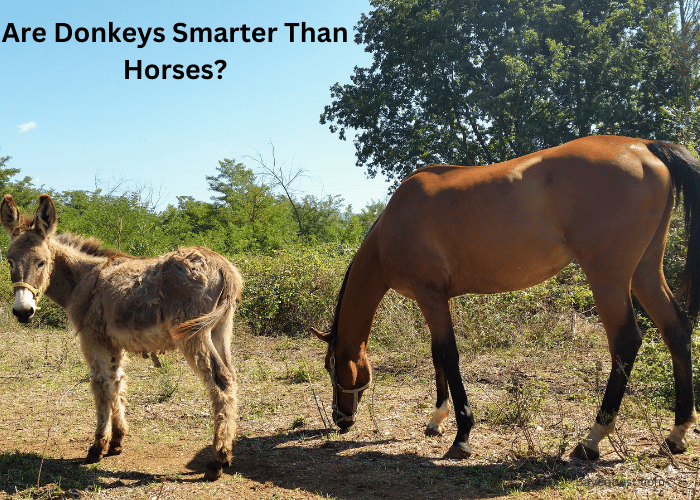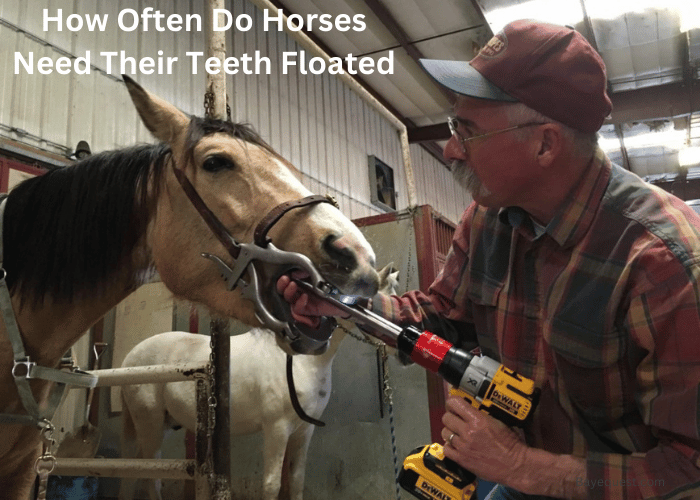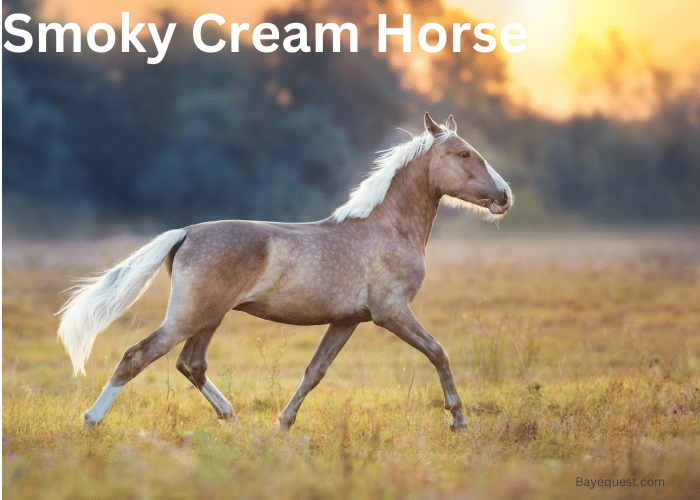As the leaves change and pumpkins pop up on every doorstep, you might wonder if your horse can join the fall festivities. After all, who doesn’t love a good pumpkin?
They’re not just for carving or pie-making; maybe your four-legged friend can enjoy them, too. But is it really safe for horses to eat pumpkins? This is a question many horse owners ask as they try to give their pets a treat.
Let’s dive into the world of horses and pumpkins, unpacking the good and the not-so-good to ensure your horse stays happy and healthy this season.
Can Horses Eat Pumpkins?
Absolutely, horses can eat pumpkins. As we roll into pumpkin season, it’s great to know these fun orange gourds are safe and healthy for your horse.
They’re packed with nutrients and can be a tasty treat for your equine friend. But, like with any treat, there are a few things to remember to ensure your horse enjoys them safely.
Is Canned Pumpkin Safe for Horses?
Yes, canned pumpkin is safe for horses, but there’s a catch. Make sure it’s plain canned pumpkin with no added sugars or spices.
This type is pure pumpkin, a good source of fiber and nutrients for your horse. Introduce it slowly into their diet to ensure it agrees with their stomach.
It’s a simple, healthy way to give your horse a special treat.
Can Horses Eat Cooked Pumpkins?
Yes, horses can eat cooked pumpkins. Cooking pumpkins softens them and makes them easier for horses to digest. This is especially helpful for older horses or those with dental issues.
Remember to keep it plain—no added sugars, spices, or seasonings. Cooked pumpkin can be a tasty, nutritious treat for your horse, just like raw pumpkin.
Always introduce any new food gradually to ensure it suits your horse’s digestive system.
Can Horses Eat Pumpkin Seeds?
No. Horses should not eat pumpkin seeds. It’s best to avoid feeding pumpkin seeds to horses.
While pumpkin flesh is a healthy treat, the seeds can be a different story. They could pose a choking hazard or cause digestive blockages, especially if eaten in large quantities.
Also, the seeds’ hard, fibrous texture could be difficult for horses to digest properly. So, when prepping pumpkin as a treat, remove the seeds and just stick to the flesh.
The Benefits of Feeding Pumpkin to Horses
Feeding pumpkin to horses offers some great benefits.
First, pumpkins contain vitamins like A, C, and E, which are super important for your horse’s immune system and overall health. They also pack a good dose of minerals like potassium, which helps with muscle function, and zinc, which is good for skin and hoof health.
Another big plus is fiber. Pumpkin has lots of it, and fiber is crucial for keeping a horse’s digestive system running smoothly. It can help prevent issues like colic and ensure everything in the gut moves as it should.
Lastly, pumpkins are low in calories and sugar. This makes them a healthy treat option, especially for horses that need to watch their weight.
Just remember to feed it in moderation, like any treat, to keep things balanced in their diet.
How Much Pumpkin Can I Feed My Horse?
When feeding pumpkin to your horse, moderation is key. Generally, a few pounds of pumpkin can be a safe amount for an average-sized horse.
This could be roughly equivalent to a couple of slices or a small, whole pumpkin divided over a few days. Always start with smaller amounts to see how your horse reacts, especially if they haven’t had pumpkins.
Introducing pumpkin slowly into your horse’s diet is important to ensure it doesn’t upset their digestive system.
Nutritional Content of Pumpkins
| Nutrient | Amount per 100g |
| Calories | 26 kcal |
| Water | 91.6 g |
| Protein | 1 g |
| Fat | 0.1 g |
| Carbohydrates | 6.5 g |
| Fiber | 0.5 g |
| Sugars | 2.8 g |
| Vitamin A | 8513 IU |
| Vitamin C | 9 mg |
| Vitamin E | 1.06 mg |
| Potassium | 340 mg |
| Calcium | 21 mg |
| Iron | 0.8 mg |
| Magnesium | 12 mg |
Tips and Tricks for Feeding Pumpkins to Horses
Pumpkins can be a delightful treat for your equine friends, especially during the fall season. Here are some tips and tricks to make sure you do it safely and effectively:
Start small. Introduce pumpkin gradually into your horse’s diet. Begin with small amounts to see how your horse reacts and ensure it doesn’t cause any digestive upset.
Preparation is key. Always remove the pumpkin’s stem, seeds, and stringy innards before feeding. These parts can be a choking hazard or cause intestinal blockage. The outer skin should also be removed if it’s particularly tough.
Serve it raw or cooked. You can feed pumpkin to your horse raw or cooked. If serving cooked, steam or bake the pumpkin without adding seasonings, sugars, or salts.
Moderation. Even though pumpkin is healthy, it should still be treated as a treat. This means it shouldn’t make up much of your horse’s diet, particularly because it can cause an imbalance if fed excessively.
Mix it up. Mix pumpkin with regular feed or other safe fruits and vegetables to make it more interesting. This can be especially useful if you’re slowly introducing pumpkin into your horse’s diet.
Check for freshness. Always use fresh pumpkin. Avoid anything spoiled or moldy, as rotten vegetables can harm horses.
Observe your horse. After feeding pumpkin for the first time, watch your horse for any signs of discomfort or allergic reactions. If you notice anything unusual, consult your vet.
How to Prepare Pumpkins for Horses
Preparing pumpkins for horses is relatively simple but requires some care to ensure it’s done safely. Here’s how to prepare pumpkins so they can be a healthy treat for your horse:
Choose the right pumpkin. Opt for a fresh, ripe pumpkin. Avoid pumpkins that are moldy or have started to rot.
Wash thoroughly. Before cutting into the pumpkin, wash the exterior thoroughly to remove any dirt or pesticides on the skin.
Remove inedible parts. Cut the pumpkin open and scoop out the seeds and stringy innards. These parts are unsuitable for horses as they can be a choking hazard or cause digestive blockages. Also, remove the hard stem and the tough outer skin, which can be difficult for horses to chew and digest.
Cut into appropriate sizes. Chop the cleaned pumpkin flesh into smaller chunks that are easy for your horse to eat. Ensure the pieces are small enough to prevent choking but large enough to give your horse something to chew on.
Raw or cooked. You can feed the pumpkin raw, which is the easiest and most nutritious way, as cooking can reduce some of the nutritional content. However, if your horse prefers or needs softer foods (such as elderly horses or those with dental issues), cooking the pumpkin is a good option. Simply steam or bake the pieces without adding seasoning, sugar, or salt.
Introduce slowly. When introducing pumpkin to your horse’s diet, start with small amounts to see how they react. Some horses may have sensitive digestive systems, and a sudden large quantity of new food could cause upset.
Monitor your horse. Keep an eye on your horse after they eat pumpkin, especially the first few times. Watch for any signs of discomfort or allergic reactions. If everything seems normal, you can make pumpkin a regular treat.
Pumpkin Treats for Horses
Pumpkin treats are a delightful and nutritious snack for horses, especially in autumn. Here are some creative ideas for making pumpkin treats that your horse will love:
Simple pumpkin cubes
- Cut fresh pumpkin into small, bite-sized cubes after removing the seeds and soft innards.
- Serve these raw, or bake them at a low temperature for a softer treat until they’re just soft enough to chew easily.
Pumpkin and oat balls
- Mix pureed pumpkin with rolled oats, a pinch of cinnamon (make sure it’s safe and the amount is minimal), and a small amount of flaxseed for binding.
- Roll the mixture into small balls and let them dry slightly in a cool oven or air dry to create a chewy treat.
Pumpkin mash
- Steam or bake pumpkin until soft, then mash it thoroughly.
- Mix with a bit of your horse’s regular grain or other safe fruits like chopped apples or carrots for added texture and flavor.
Frozen pumpkin treats
- Puree cooked or raw pumpkin and pour it into ice cube trays or small molds.
- Freeze the trays and give these frozen treats to your horse as a refreshing snack on a warm day.
Baked pumpkin cookies
- Combine pureed pumpkin with ingredients like crushed hay pellets, a small amount of molasses for sweetness, and whole wheat flour to bind.
- Drop spoonfuls of the mixture onto a baking sheet and bake at a low temperature until dry and firm.
Pumpkin and carrot sticks
- Mix grated pumpkin and carrots, add a bit of honey for stickiness, and form them into sticks or bars.
- Dry these in a low-heat oven to create a crunchy, healthy treat.
Risks of Horses Feeding on Pumpkins
Feeding pumpkins to horses can be beneficial, but it’s important to be aware of potential risks to ensure their health and safety. Here are some of the risks associated with feeding pumpkins to horses:
Choking hazard. Large pumpkin chunks can pose a choking risk, especially if the horse tries to swallow them without proper chewing. Always cut the pumpkin into sized pieces that your horse can easily chew.
Gastrointestinal blockages. The fibrous strands and seeds inside the pumpkin can block a horse’s digestive tract if not removed before feeding. Always clean out the seeds and fibrous material before giving the pumpkin to your horse.
Nutritional imbalances. While pumpkin is healthy, it should not replace a significant portion of a horse’s regular diet. Feeding too much pumpkin can lead to nutritional imbalances.
Pesticide exposure. If the pumpkin has been treated with pesticides and not washed properly, there could be a risk of chemical exposure. Always wash the pumpkin thoroughly before preparing it for your horse.
Mold and decay. Rotten or moldy pumpkin can be toxic and should never be fed to horses. Mold can produce mycotoxins that harm horses, leading to serious health issues. Always use fresh pumpkin and inspect it for signs of spoilage before feeding.
Allergic reactions. As with any new food, there is a possibility of allergies. Introduce pumpkin to a horse’s diet gradually and monitor for any signs of allergic reaction.
Pumpkin Alternatives
If you’re looking for alternatives to pumpkin that are safe and healthy for horses, here are some options that can provide similar nutritional benefits and variety:
- Carrots
- Apples
- Sweet Potatoes
- Bananas
- Pears
- Beets
- Zucchini
- Celery
- Squash
- Watermelon
- Cucumber
- Oranges
- Grapes
- Strawberries
- Broccoli
Food Not to Feed Horses
Certain foods can harm horses and should be avoided to ensure their health and safety. Here’s a list of foods not to feed horses:
- Chocolate
- Avocado
- Caffeine
- Alcohol
- Meat and dairy
- Onions and garlic
- Potatoes and other nightshades
- Bread and other fermentable foods
- Lawn clippings
- Rhubarb
- Stone fruit pits
- Moldy or spoiled foods
FAQs
Can horses eat broccoli?
Yes, horses can eat broccoli. It should be given in moderation as part of a varied diet. Broccoli is rich in nutrients but can cause gas, so introduce it slowly and watch for any digestive upset.
Can horses eat cucumber?
Yes, horses can eat cucumber. Cucumbers are mostly water, making them a low-calorie, hydrating snack. They can be a refreshing treat, especially in hot weather, but should be fed in moderation.
Read more on horses feeding on cucumbers in our insightful blog.
Can horses eat oranges?
Yes, horses can eat oranges. Oranges are a good source of vitamin C and can be fed in small quantities as a treat. However, the peel should be removed to avoid digestive issues, and like any new food, oranges should be introduced into the horse’s diet gradually.
Related read: Should horses eat oranges?
Conclusion
So, there you have it. Pumpkins can be more than just a festive decoration—they’re a tasty and nutritious treat for your horse.
Remove the seeds, go easy on the portions, and introduce them slowly into your horse’s diet. A little pumpkin can add seasonal fun to your horse’s routine, whether it’s a sunny fall day or a crisp autumn evening.
So, save a little for your four-legged friend the next time you’re scooping out a pumpkin for carving. They’ll surely thank you for the tasty treat.










